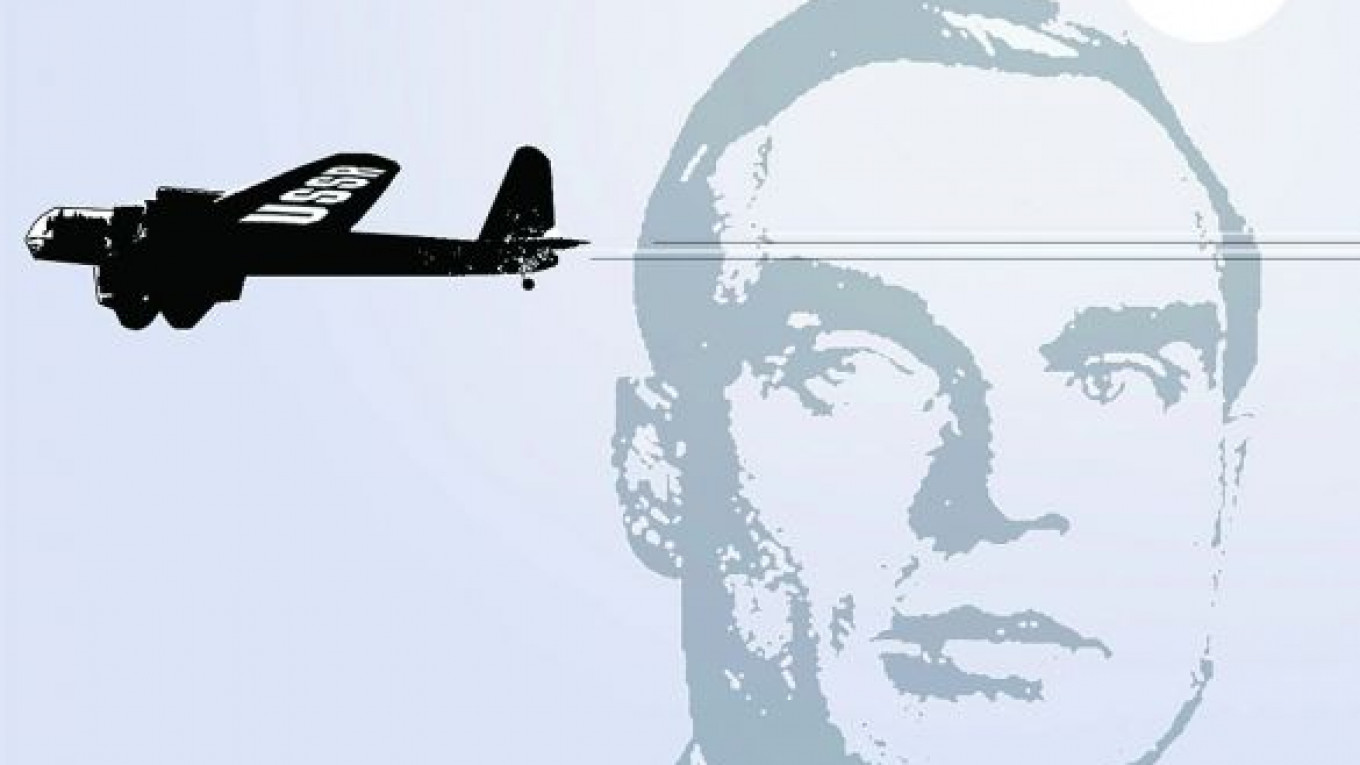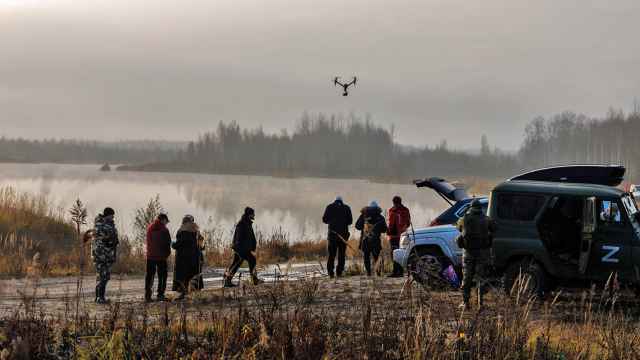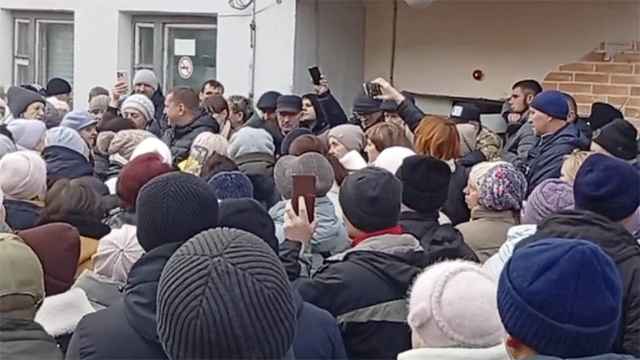A memorial honoring Sigizmund Levanevsky — a Soviet pilot dubbed by the U.S. media as the "Russian Lindbergh" — was unveiled at the Khrunichev Space Center to commemorate the 75th anniversary of his unexplained death last month. For decades, Levanevsky has been a symbol of Russian-U.S. cooperation in the aerospace field.
Levanevsky and his crew of six went missing over Alaska as they attempted to make the first cargo-passenger flight from Moscow to Fairbanks, Alaska.
Fairbanks was chosen because, at a distance of 6,650 kilometers from Moscow, it fell within the range of the airplane that Levanevsky would fly — a bomber that had been converted into an N-209 civilian aircraft. The aircraft's designers cautioned that the plane was still untested, but Soviet pilots had established several records on it and planned to demonstrate it to the Americans. A full year was needed to prepare for the flight, but the Soviet official in charge of the project, wanting to curry favor with Josef Stalin, gave only three months.
Unfortunately, under such a tight timeframe, the flight crew never got a chance to gel. They made several short training flights, such as a 1,930-kilometer roundtrip from Moscow to Melitopol, Ukraine, but didn't fly 30 hours or more nonstop to test the aircraft on distances comparable to the Moscow-Fairbanks route. Neither did they fly blind to test the plane in conditions of poor visibility.
All of this made the crew jittery before the big flight. That is why, as the men set out on Aug. 12, 1937, the crew's radio operator said, half-jokingly, "We are flying to our deaths."
In a first, Soviet authorities permitted foreign correspondents based in Moscow to watch the takeoff. The New York Times correspondent posed a sensitive question to Levanevsky, asking: "My Levanevsky, do you feel lucky this time?"
"I think we were very lucky to be entrusted with this flight," he responded, "and I believe that people will fly this route — with or without us."
The four-propeller N-209 took off quickly — in only 35 seconds — but the far right engine was trailing smoke. Engineers predicted that the engine would soon stop smoking but, 19 hours later, the last radio message received from the crew referred to the same problem: "The far-right engine has quit due to a problem with the oil system … Entering overcast skies … Elevation 4,600 meters. Will attempt a landing."
The search began the next day. In Washington, Soviet Ambassabor Konstantin Umansky contacted famed Arctic explorer Vilhjalmur Stefansson, who offered to rent three airplanes to fly to Alaska and search along the 148th meridian, which Levansky had been following as the plane's route to Fairbanks.
By Aug. 14, two days after the departure from Moscow, three American and one Canadian team started combing the coastal islands of Alaska.
Stefansson, meanwhile, recruited several outstanding men for his search party, including experienced polar explorer Sir Hubert Wilkins. The Soviet Embassy rented a seaplane, and on Aug. 22, Wilkins and his team flew to Alaska and made five long-range flights toward the North Pole before the Arctic Ocean began to freeze over.
Finding nothing, they returned to New York, where they followed Stefansson's advice and purchased the most modern airplane available, the Lockheed Electra. The crew soon flew back to the Arctic.
Wilkins benefited from a string of clear lunar days with good visibility, but he found nothing. The icebreaker Krasin arrived at Point Barrow from Chukotka and delivered several short-range airplanes. The ship was also to act as a radio beacon for two seaplanes. However, the ice soon began closing off all water routes, and the Krasin was forced to return to Chukotka with the airplanes.
Many polar pilots conjectured that Levanevsky's aircraft iced over, went out of control and crashed. Polar radio operators and amateur radio buffs from a number of countries reported picking up an extremely faint distress call from Levanevsky's crew.
The crew had taken off from Moscow with a six-week supply of food, weapons for hunting and sleeping bags. Just before takeoff, they also were given bags containing furs to present to the wives of prominent U.S. officials, a barrel of caviar and letters to post in the United States. But for some reason they left their emergency radio behind.
Levanevsky was only 35 years old at the time of his last flight, and his disappearance shook the world. A year after the tragic event, Soviet pilot Valery Chkalov recalled Levanevsky, saying, "You see, only death could keep him from his goal. The skies will make us pay dearly for a long time." Chkalov himself died several months later while testing a new fighter plane.
In 1989, while working at the U.S. Library of Congress, I was reading old radio messages and found that in the fall of 1937, radio operator Stanley Morgan, who was based at Point Barrow, met with Eskimos from Oliktok Point, an area about 250 to 300 kilometers to the east. Looking through binoculars, three Eskimos had seen a large flying machine about 15 kilometers north of the mainland and flying at low altitude. It hit the water, pulled up and then crashed into the sea near the Jones Islands. It was a stormy, rainy evening.
The next day, the Eskimos sailed out to the scene of the accident and found an oil slick. One Eskimo, who was also a college student, took note of the incident in his diary. Radioman Morgan informed his superiors of what he had learned.
A year later, a clergyman from California, Homer Kellems, sailed into Barrow on his schooner. Morgan related the story he had heard from the Eskimos, and Kellems used the only tool available to search for the wreckage of the Soviet aircraft — a compass. At one point, a sailor noticed the compass pointing downward and informed Kellems, but he was unable to find anything.
Ice soon began forming near the islands, and Kellems quickly sailed back to California. From there, he wrote a detailed letter describing his efforts to the Soviet Embassy, which in turn forwarded his letter and Morgan's radio message to the Foreign Affairs Commissariat, where the documents were placed in the archives.
Then World War II broke out, and the Levanevsky search was shelved.
In 2011, I had the opportunity to meet specialists at the Geophysical Institute at the University of Alaska, Fairbanks. In different years and with different teams, they had organized four short expeditions to the site where the airplane was thought to have crashed.
Using magnetometers and sonar from both sea and ice, they managed to scan 5 square kilometers of the 36 square kilometers in question. Continuing the search will require additional resources, modern geophysical equipment and plenty of young geophysics volunteers. They will be looking for the airplane's four large 900-kilogram engines and other metal parts that probably remain intact, even after the passage of 75 years.
Today, when the United States and Russia are actively working to develop the Arctic Shelf, the joint search for the aircraft flown by Sigizmund Levanevsky — a pioneer of the Arctic air route — could become a symbol of scientific collaboration between the two countries. Only through the cooperative efforts of American, Canadian and Russian enthusiasts will it be possible to establish once and for all whether Levanevsky and his crew went down over Alaska.
Correction: An earlier version of this article misquoted the last radio message of the N-209 as saying the plane's elevation was 1,500 feet instead of 4,600 meters. An earlier version of this article also misstated the weight of the airplane's engines as being 270 kilograms each instead of 900 kilograms.
Yury Salnikov is a member of the Russian Geographic Society and has made documentary films on aviation history and Arctic exploration.
A Message from The Moscow Times:
Dear readers,
We are facing unprecedented challenges. Russia's Prosecutor General's Office has designated The Moscow Times as an "undesirable" organization, criminalizing our work and putting our staff at risk of prosecution. This follows our earlier unjust labeling as a "foreign agent."
These actions are direct attempts to silence independent journalism in Russia. The authorities claim our work "discredits the decisions of the Russian leadership." We see things differently: we strive to provide accurate, unbiased reporting on Russia.
We, the journalists of The Moscow Times, refuse to be silenced. But to continue our work, we need your help.
Your support, no matter how small, makes a world of difference. If you can, please support us monthly starting from just $2. It's quick to set up, and every contribution makes a significant impact.
By supporting The Moscow Times, you're defending open, independent journalism in the face of repression. Thank you for standing with us.
Remind me later.






